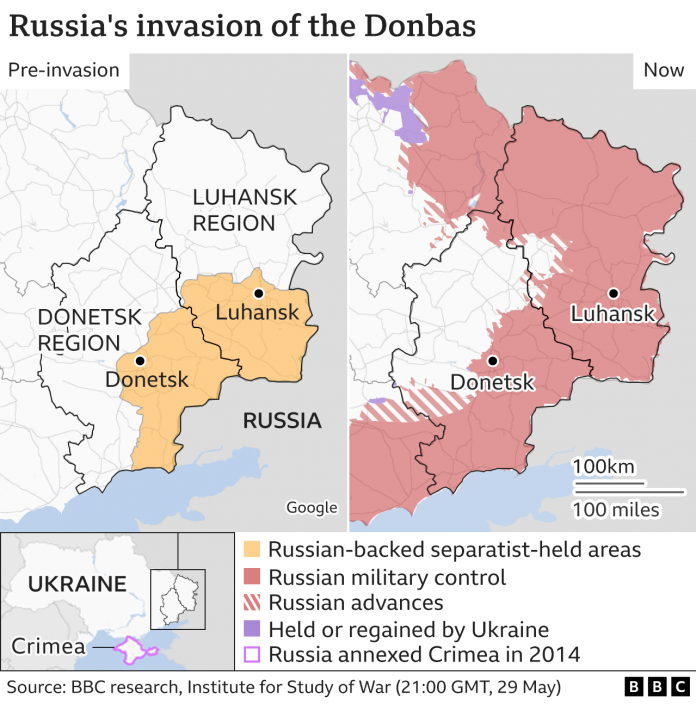There is heavy fighting in east Ukraine, with key locations under intense bombardment from Russian forces.
Here are the latest developments:
- Russian troops are trying to encircle Severodonetsk and Lysychansk, targeting Ukrainian positions with artillery and heavy mortars
- Russian troops are pushing north from the town of Popasna, attacking Ukrainian supply routes
- Russia’s foreign minister says taking control of the Donbas region in eastern Ukraine is an “unconditional priority”.
Russia advancing in the east
Russian officials have said their forces are fighting for the “complete liberation” of the Donbas, which broadly refers to Ukraine’s eastern regions of Donetsk and Luhansk, where Russian-backed separatists held significant territory before the invasion.
Russia now controls more than 90% of Luhansk and has made significant advances in Donetsk since Russia’s invasion on 24 February.


Eastern cities and supply routes under attack
Russian forces are closing in on Severodonetsk from three sides, with some parts of the city within range of heavy mortar fire.
Defence analyst Professor Michael Clarke, of King’s College London, said Ukrainian forces faced a crucial decision about whether to try to save the city, or withdraw to safer ground further west.
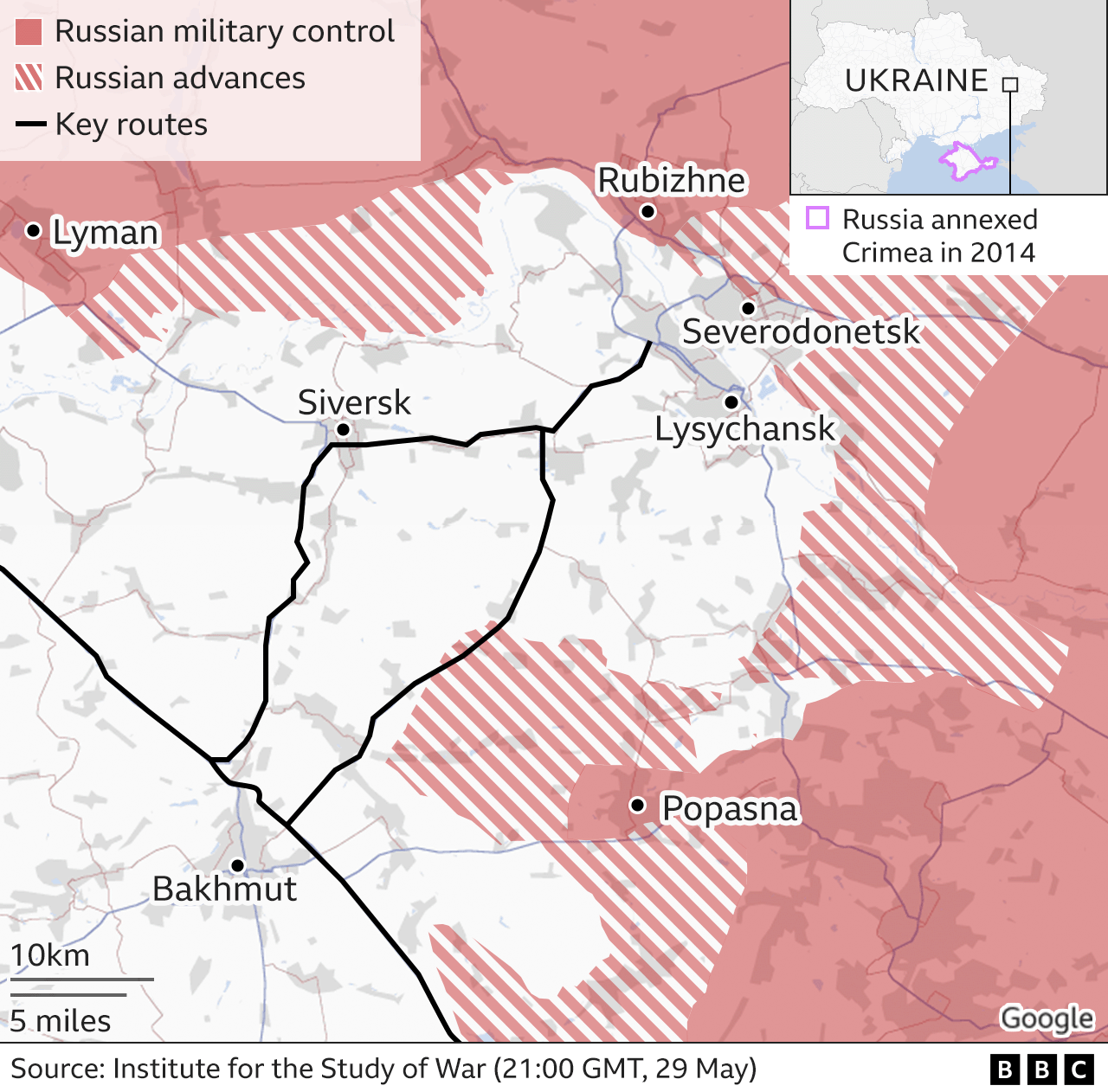
He said Ukraine needed long-range Western artillery, so they could hold the Russian forces back.
The Institute for the Study of War says the Russian campaign appears to be focused almost entirely on Severodonetsk, which means they are likely to deprioritize advances southeast of Izyum and west of Lyman.
A spokesman for the Luhansk region said 90% of houses in Severodonetsk had been destroyed and there was virtually no gas, water or electricity.
A Russian attempt to push south from Izyum along the road to Slovyansk was effectively stalled by Ukrainian forces.
However, Russian troops have moved north from Popasna, with the key supply route from Bakhmut to Lysychansk being bombarded by Russian artillery.
Should the route be taken by Russia, Severodonetsk and Lysychansk would be left with one supply road via Siversk.
Reports suggest that Lyman is now under Russian control, and forces are now regrouping to try to take the city of Slovyansk,

Russia’s ‘Frankenstein forces’ inching forward
Russian forces have suffered heavy losses since the invasion began.
The UK Ministry of Defence (MoD) says Russia is likely to have suffered devastating losses among its middle and junior ranking officers, because they have been deployed at the front lines of fighting. It says these losses are likely to contribute to a loss of morale and poor discipline among lower ranks.
Significant quantities of Russian weaponry have also been destroyed.
As a result, Russia has tried to combine some heavily depleted units, forming what some analysts have called ‘Frankenstein forces’ to fight in the east.
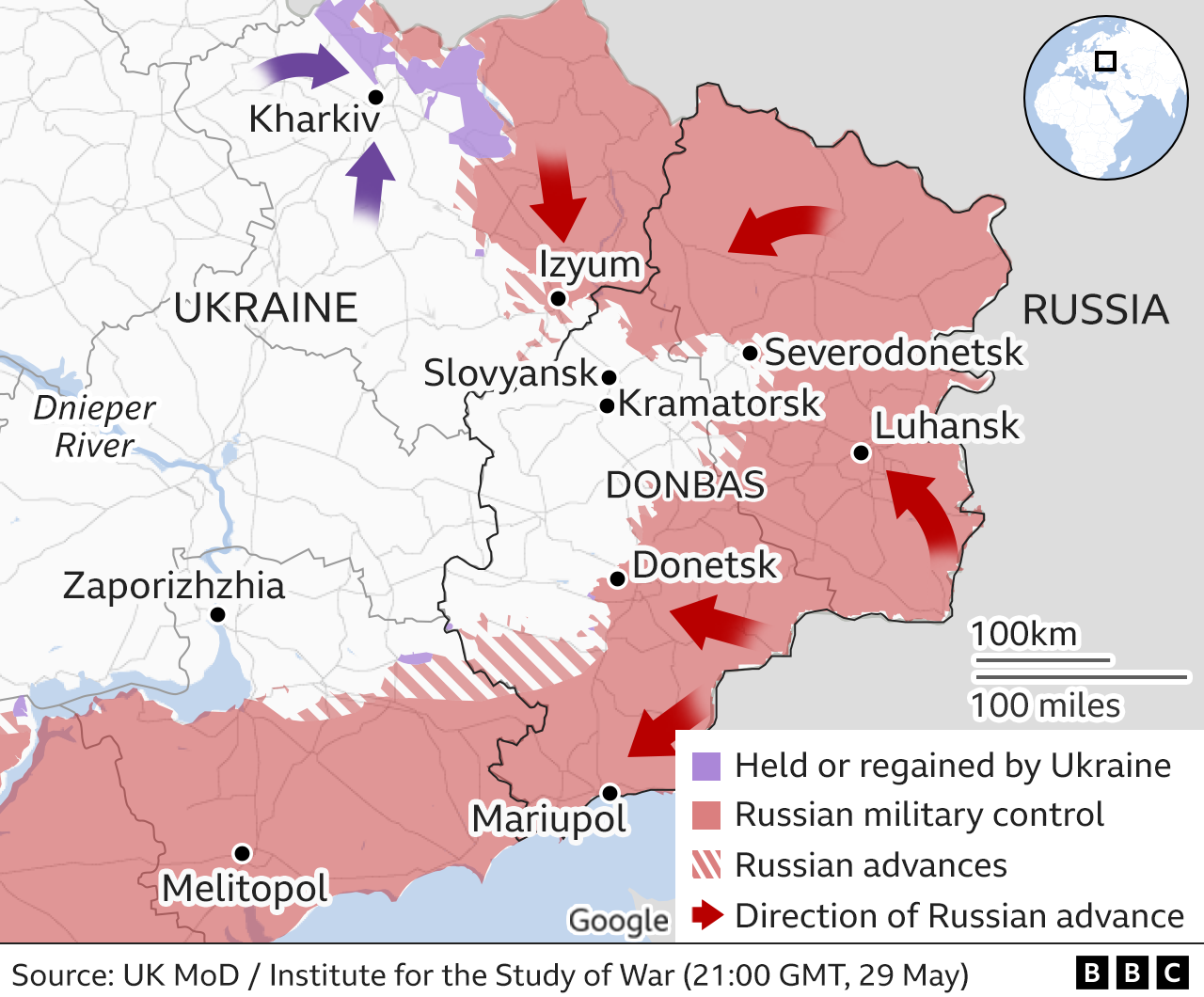
Ukraine has successfully pushed Russian forces away from Kharkiv, though Russian units are continuing to shell some parts of the city, according to the Institute for the Study of War (ISW).
Ukraine’s President Volodymyr Zelensky visited troops in the Kharkiv region on Sunday (28 May), his first official trip outside the Kyiv region since the Russian invasion began.
In southern Donetsk, Russia is now fully in control of the port city of Mariupol.
The siege of Mariupol, which lasted more than two months, came to an end on 20 May.
Analysts say the fall of the city may enable Russian units to join the fight in other areas such as Zaporizhzhia, where the shelling of Ukrainian forces is ongoing.

War in Ukraine: More coverage
- SOLDIER: ‘Friends die in your arms’
- SOUTHERN FRONT: Russia’s new propaganda machine
- WEAPONS: What is being given to Ukraine by the UK?
- READ MORE: Full coverage of the crisis

Russia targeting full control of south
Russian forces initially made rapid gains in the south, with their main objective being the creation of a land corridor between Crimea, which it annexed in 2014, and areas held by Russian-backed separatists in Donetsk and Luhansk.
But strong resistance from Ukrainian forces near Mykolaiv in the west and in Mariupol significantly slowed Russian advances.
To the west, Russia had aimed to take control of Odesa and cut off Ukraine’s access to the Black Sea, but its forces were blocked by a staunch defence in Mykolaiv and forced back towards Kherson by a Ukrainian counteroffensive in March.
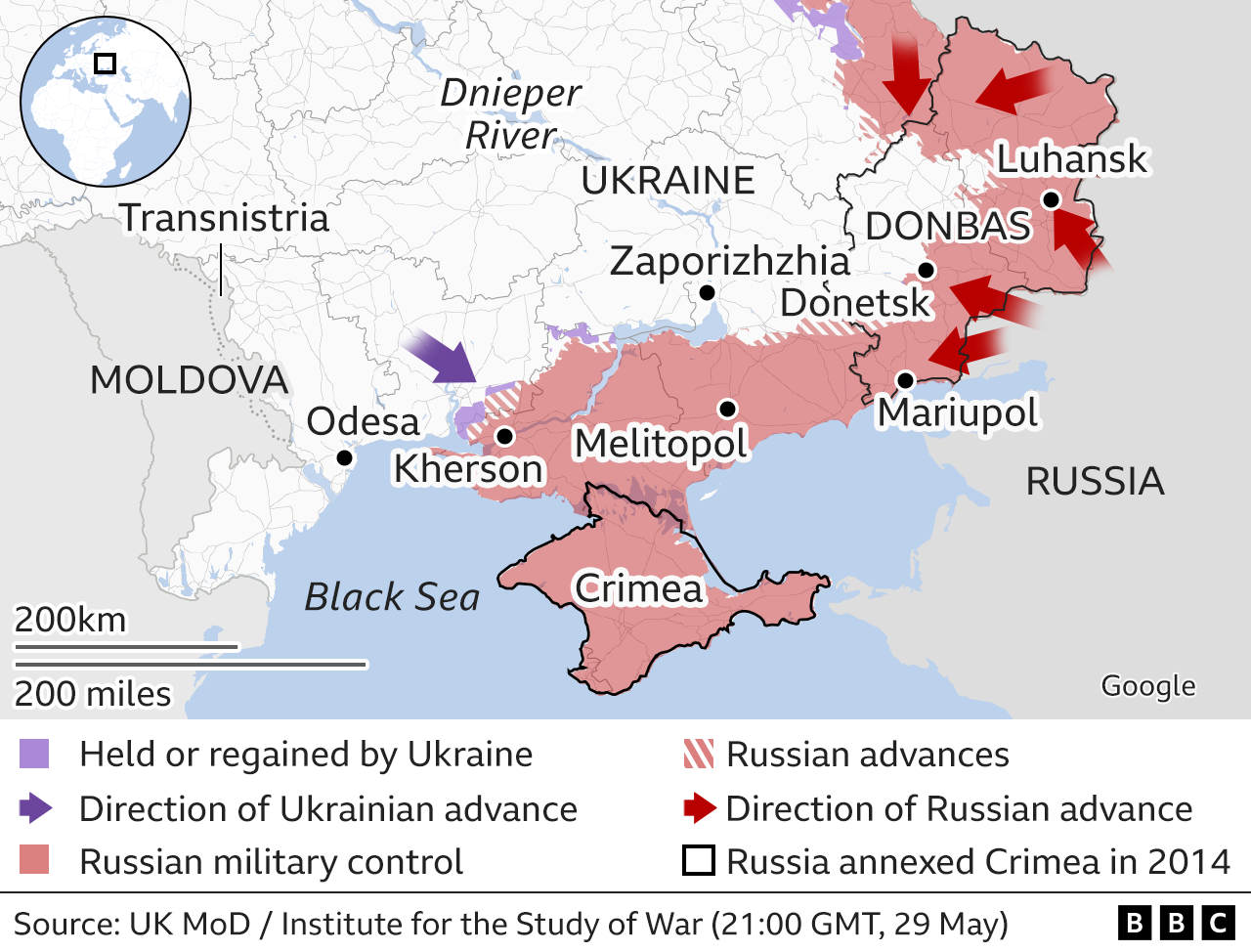

Russia invaded Ukraine on 24 February, but Ukrainian forces retook large areas around Kyiv in early April after Russia abandoned its push towards the capital.
Areas in the west of the country, including Lviv, have seen missile attacks but no attempt to take and occupy ground by Russian forces.
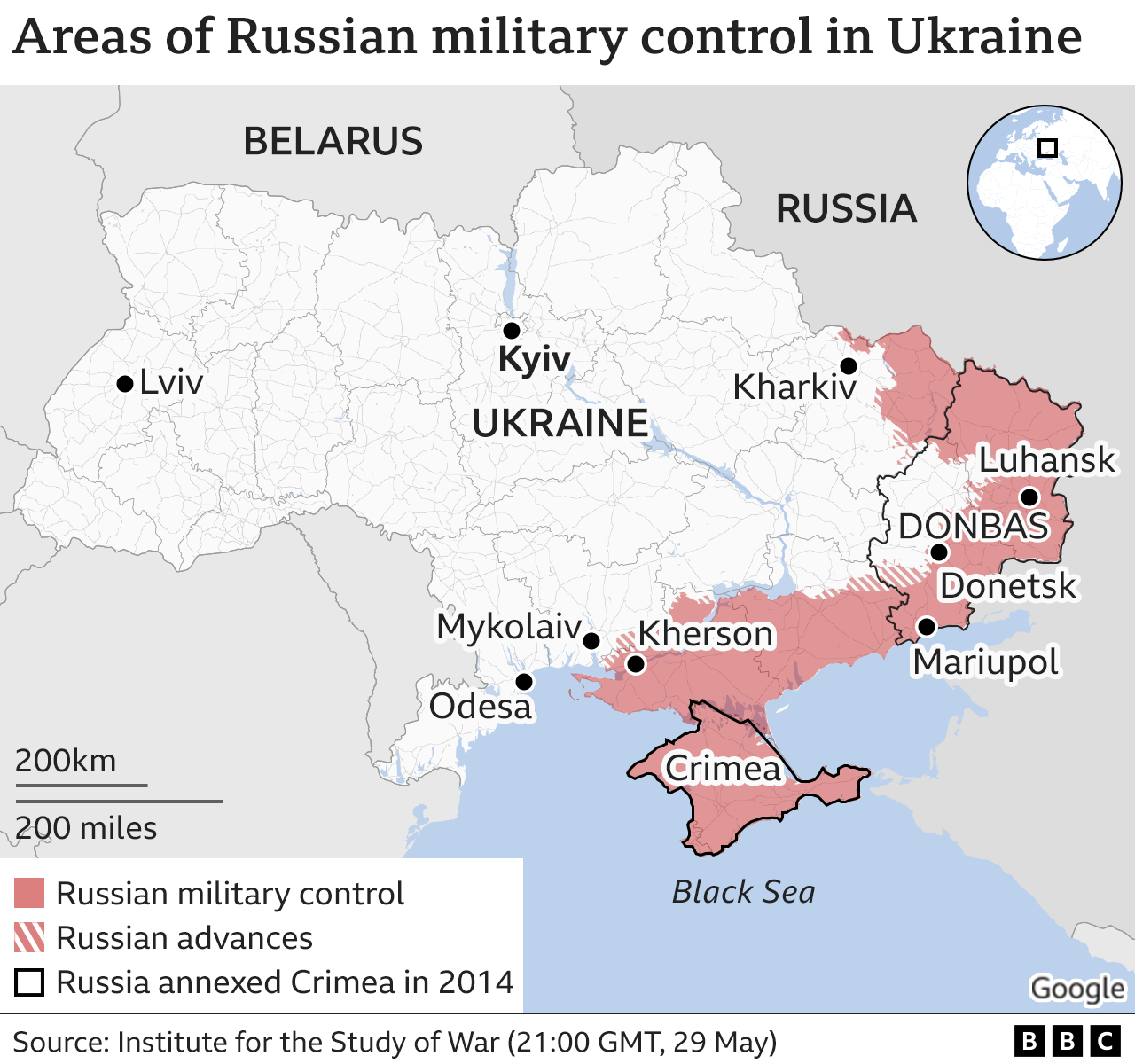

By David Brown, Bella Hurrell, Dominic Bailey, Mike Hills, Lucy Rodgers, Paul Sargeant, Alison Trowsdale, Tural Ahmedzade, Mark Bryson, Zoe Bartholomew, Sean Willmott, Sana Dionysiou, Joy Roxas, Gerry Fletcher, Jana Tauschinsk, Debie Loizou, Simon Martin and Prina Shah.

About these maps
To indicate which parts of Ukraine are under control by Russian troops we are using daily assessments published by the Institute for the Study of War with the American Enterprise Institute’s Critical Threats Project.
To show key areas where advances are taking place we are also using daily updates from the UK Ministry of Defence and BBC research.
The situation in Ukraine is fast moving and it is likely there will be times when there have been changes not reflected in the maps.

